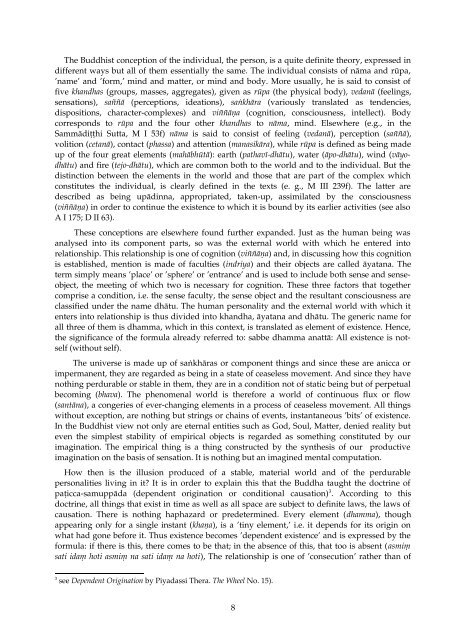The Truth of Anatta - Buddhist Publication Society
The Truth of Anatta - Buddhist Publication Society
The Truth of Anatta - Buddhist Publication Society
Create successful ePaper yourself
Turn your PDF publications into a flip-book with our unique Google optimized e-Paper software.
<strong>The</strong> <strong>Buddhist</strong> conception <strong>of</strong> the individual, the person, is a quite definite theory, expressed in<br />
different ways but all <strong>of</strong> them essentially the same. <strong>The</strong> individual consists <strong>of</strong> nāma and rūpa,<br />
’name’ and ’form,’ mind and matter, or mind and body. More usually, he is said to consist <strong>of</strong><br />
five khandhas (groups, masses, aggregates), given as rūpa (the physical body), vedanā (feelings,<br />
sensations), saññā (perceptions, ideations), saṅkhāra (variously translated as tendencies,<br />
dispositions, character-complexes) and viññāṇa (cognition, consciousness, intellect). Body<br />
corresponds to rūpa and the four other khandhas to nāma, mind. Elsewhere (e.g., in the<br />
Sammādiṭṭhi Sutta, M I 53f) nāma is said to consist <strong>of</strong> feeling (vedanā), perception (saññā),<br />
volition (cetanā), contact (phassa) and attention (manasikāra), while rūpa is defined as being made<br />
up <strong>of</strong> the four great elements (mahābhūtā): earth (pathavī-dhātu), water (āpo-dhātu), wind (vāyodhātu)<br />
and fire (tejo-dhātu), which are common both to the world and to the individual. But the<br />
distinction between the elements in the world and those that are part <strong>of</strong> the complex which<br />
constitutes the individual, is clearly defined in the texts (e. g., M III 239f). <strong>The</strong> latter are<br />
described as being upādinna, appropriated, taken-up, assimilated by the consciousness<br />
(viññāṇa) in order to continue the existence to which it is bound by its earlier activities (see also<br />
A I 175; D II 63).<br />
<strong>The</strong>se conceptions are elsewhere found further expanded. Just as the human being was<br />
analysed into its component parts, so was the external world with which he entered into<br />
relationship. This relationship is one <strong>of</strong> cognition (viññāṇa) and, in discussing how this cognition<br />
is established, mention is made <strong>of</strong> faculties (indriya) and their objects are called āyatana. <strong>The</strong><br />
term simply means ’place’ or ’sphere’ or ’entrance’ and is used to include both sense and senseobject,<br />
the meeting <strong>of</strong> which two is necessary for cognition. <strong>The</strong>se three factors that together<br />
comprise a condition, i.e. the sense faculty, the sense object and the resultant consciousness are<br />
classified under the name dhātu. <strong>The</strong> human personality and the external world with which it<br />
enters into relationship is thus divided into khandha, āyatana and dhātu. <strong>The</strong> generic name for<br />
all three <strong>of</strong> them is dhamma, which in this context, is translated as element <strong>of</strong> existence. Hence,<br />
the significance <strong>of</strong> the formula already referred to: sabbe dhamma anattā: All existence is notself<br />
(without self).<br />
<strong>The</strong> universe is made up <strong>of</strong> saṅkhāras or component things and since these are anicca or<br />
impermanent, they are regarded as being in a state <strong>of</strong> ceaseless movement. And since they have<br />
nothing perdurable or stable in them, they are in a condition not <strong>of</strong> static being but <strong>of</strong> perpetual<br />
becoming (bhava). <strong>The</strong> phenomenal world is therefore a world <strong>of</strong> continuous flux or flow<br />
(santāna), a congeries <strong>of</strong> ever-changing elements in a process <strong>of</strong> ceaseless movement. All things<br />
without exception, are nothing but strings or chains <strong>of</strong> events, instantaneous ’bits’ <strong>of</strong> existence.<br />
In the <strong>Buddhist</strong> view not only are eternal entities such as God, Soul, Matter, denied reality but<br />
even the simplest stability <strong>of</strong> empirical objects is regarded as something constituted by our<br />
imagination. <strong>The</strong> empirical thing is a thing constructed by the synthesis <strong>of</strong> our productive<br />
imagination on the basis <strong>of</strong> sensation. It is nothing but an imagined mental computation.<br />
How then is the illusion produced <strong>of</strong> a stable, material world and <strong>of</strong> the perdurable<br />
personalities living in it It is in order to explain this that the Buddha taught the doctrine <strong>of</strong><br />
paṭicca-samuppāda (dependent origination or conditional causation) 3 . According to this<br />
doctrine, all things that exist in time as well as all space are subject to definite laws, the laws <strong>of</strong><br />
causation. <strong>The</strong>re is nothing haphazard or predetermined. Every element (dhamma), though<br />
appearing only for a single instant (khaṇa), is a ’tiny element,’ i.e. it depends for its origin on<br />
what had gone before it. Thus existence becomes ’dependent existence’ and is expressed by the<br />
formula: if there is this, there comes to be that; in the absence <strong>of</strong> this, that too is absent (asmiṃ<br />
sati idaṃ hoti asmiṃ na sati idaṃ na hoti), <strong>The</strong> relationship is one <strong>of</strong> ’consecution’ rather than <strong>of</strong><br />
3<br />
see Dependent Origination by Piyadassi <strong>The</strong>ra. <strong>The</strong> Wheel No. 15).<br />
8

















